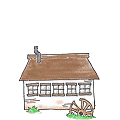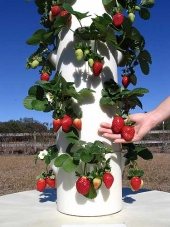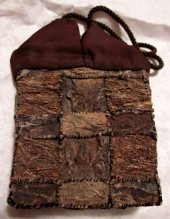posted 1 year ago
I use arbutus bark for dyeing. The tree sheds naturally (some First nations called it 'crazy woman tree' because she takes off her clothes year 'round) and I always have an extra pocket or two for gathering the bark when I'm in the woodlot.
There's a bag in the kitchen - next to the one for onion skins - where I keep the bark until I'm ready to use it. I keep it out of the light and in a paper bag so it can breathe and dry.
Pre step: weigh fibre/yarn/cloth while dry.
Step one: prep the fabric.
Commercially woven fabric will have some extra grease or sizing on it so that it could go through the machines easier. This will act as a resist - make the dye not want to grab onto the fibres.
I like to scour or wash (scour involves very specific temperatures - wash is washing). Water so hot that 2 seconds is the maximum I can put my hand in it without damage. Should be steaming. Real soap if you have it (fat and lye soap - from mutton tallow is traditional). I use orvas paste which I get from the farm shop. You can also buy this from most dye supply shops for a crazy price, but given that I only need one to three teaspoons per fleece, the gallon jug from the feed shop lasts me several years. I use this because it claims to be biodegradable and my plants confirm it doesn't hurt them, they use it to wash lambs, and it is one of the few cleaning agents that doesn't hurt my skin.
But also, use what you got. Dish detergent I'm told gives very good results. Clothing detergent is probably the least beneficial as it often has additives to make the clothing appear more clean but can act as a resist for the dye.
dissolve soap or detergent in the extremely hot water. Press the cloth into the water. Reposition after a min or two to make sure the soap is in the cloth. Repeat as needed. Remove cloth from soapy water before water cools (to prevent stuff from reaffixing to the fibres).
Rinse in warm to hot water.
Note the low amount of agitation. (for those of you new to wool, agitation, plus moisture and/or temperature change can cause fulling (felting) which shrinks and thickens the cloth - not always desirable)
Optional step: mordant.
Alum is popular. Again, I buy mine from the agricultural supply as I'm not dyeing to reproduce a specific colour so I don't need the most pure (and expensive) alum.
Heat water to a scant boil. Add 5-10% WOF (dry Weight Of the Fibre/yarn/fabric) of alum. Stir and add cloth. Bring to just below a boil and then turn off heat and leave for overnight to cool.
I don't find arbutus needs a mordant, but it does increase lightfastness.
Step... what was I on? Dye day
If memory serves, the recommended WOF for arbutus bark is 50%.
WOF is confusing. How to explain?
Recipes in natural dyeing are based on the weight of the fibre/yarn/cloth to be dyed. The dry weight of the fibre is considered 100% and everything else is in relationship to that. Mordant is usually 2-10%. Dyestuff can be anywhere from 5% to 600%. Depending on stuff.
I tend to ignore the WOF thing when it comes to dye stuff. I have my amount of dyestuff (which is roughly the size of my dye pot) and the amount of stuff to dye (about twice what one should put in a dye pot). There isn't much room for negotiation. Most dyers can't be near me when I dye because I do things so wrong. But it works for me, so I'm happy.
Okay...um... pot full of bark. Pour some boiling water from the kettle on it to speed things up. I bring it to a boil and simmer for maybe an hour. If the water looks dark, I leave the bark in the water overnight to cool.
Remember to soak cloth.
Next day, strain the bark (keep the bark, you might be able to make another dye bath from that). Oh, and keep the water.
Put the cloth in the dye bath and top up with water if needed. Bring to below a boil and then lower to just below a simmer for about an hour. Leave in the dye bath to cool.
Have a look at the cloth. Is it dark enough?
If yes, then wash it really really well with soap and water (like step one)
If no, then is there colour still in the water?
Yes? reheat cloth in dye bath.
No? we need to find more colour. Try making a dye bath out of the bark to see if there could be more colour extracted.
If you don't have enough dye stuff now, you can dry the cloth until you have enough bark to do another dip.
Hope that makes sense. Feel free to ask questions.











